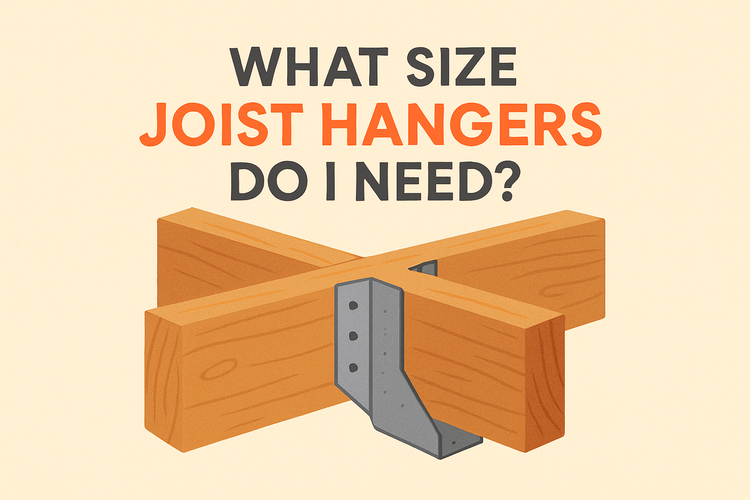What Size Joist Hangers Do I Need

Understanding Joist Sizes and Their Corresponding Hangers
Joist hangers are sized to match the lumber they support, so understanding your joist dimensions is the first step. The most common joist sizes include 2x6, 2x8, 2x10, and 2x12 boards.
The size of the joist directly determines the hangers you need. For example, a 2x10 joist requires a joist hanger designed specifically for 2x10 lumber. Using undersized or oversized hangers can weaken the structural integrity and could potentially lead to failure under load. Most manufacturers provide a straightforward chart or labeling system to match hanger models to joist sizes, making it easy to find the right fit during construction or renovation projects.
Additionally, hangers are designed for dimensional lumber, which may not always be exactly the size stated. A 2x10 nominal board, for example, may actually measure 1.5 inches thick and 9.25 inches tall. Joist hangers accommodate these real dimensions, which is why standardization is so important. Taking accurate measurements and checking manufacturer specifications is essential when choosing a hanger to ensure a tight, supportive fit.
Choosing Between Face-Mount and Top-Mount Joist Hangers
The installation method of joist hangers varies depending on the application, and understanding the difference can save time and effort.
Face-mount hangers, the most common type, are attached to the face of the beam or ledger and support the joist’s end. These are typically used when installing joists perpendicular to beams or headers. Top-mount hangers, on the other hand, are nailed into the top edge of a beam, allowing the joist to sit flush with the beam for a level finish. These are often used in concealed applications or where vertical space is limited.
Face-mount hangers tend to provide better lateral support and are easier to install during new construction. They also come in various configurations, including sloped or skewed versions to accommodate angled joists. Top-mount hangers may require pre-planning and might not be suitable for retrofit situations. Before selecting a hanger type, evaluate your framing layout and loading requirements to ensure compatibility and functionality.
Using the correct mount style also plays a role in how efficiently loads are transferred through your framing system. In multi-level constructions or decks, it’s crucial to align the hanger type with the entire design to maintain uniform strength throughout the structure.
Accounting for Load Requirements and Engineering Specifications
Not all joist hangers are created equal in load-carrying capacity. It's important to match the hanger not only to the joist size but also to the supported load.
Manufacturers provide load tables for each hanger model, specifying two main values: the allowable download (vertical load) and lateral load (horizontal forces). These tables consider variables like wood species, fastener type, and installation angle. For heavily loaded joists—such as those supporting decks or storage areas—select heavier-duty hangers made from thicker galvanized steel and designed for increased shear and bearing strength.
Structural engineers may specify particular hanger models in their drawings, especially in commercial or custom residential settings. If you’re working from engineered plans, always match the hanger model and fastener schedule exactly—substitutes can invalidate code compliance or compromise safety. In projects lacking formal engineering, consulting hanger load charts becomes even more critical.
Oversizing a joist hanger doesn't necessarily solve load issues, and in some cases, it may even weaken the joint by allowing too much movement. Ensuring the hangers you choose are rated for the actual structural load will keep the assembly sound and increase its lifespan.
Selecting the Right Fasteners for Joist Hangers
Choosing the correct nails or screws is just as vital as selecting the right hanger size.
Joist hangers are tested and rated assuming specific fasteners, typically 10d or 16d galvanized nails or proprietary structural screws recommended by the manufacturer. Using different or smaller fasteners can drastically reduce the carrying capacity of the hanger. For instance, drywall screws should never be used, as they can snap under load and don’t provide the shear strength necessary for structural applications.
Some modern hangers accept structural screws, which are easier to drive and provide better holding power than traditional nails. Always check the label or product specification sheet to find out exactly what fasteners are required, including diameter, length, and material type. Corrosion-resistant fasteners are essential for exterior applications or when using treated lumber, which can corrode regular steel over time.
Proper nailing patterns also affect the performance of joist hangers. Partial or incorrect nailing can reduce load capacity significantly. It’s good practice to use pre-drilled nail holes as a guide and avoid improvising with pattern or spacing. Proper installation goes hand-in-hand with using the correct hanger size to ensure your structural framing performs safely and effectively.
Code Compliance and Inspection Considerations
Building codes provide clear guidelines about hanger use, and failing to follow them can lead to costly delays or required rebuilds.
Most residential and commercial building codes mandate that joist hangers be listed and approved by code agencies like the International Code Council (ICC). These approvals ensure the hanger meets minimum performance standards. Inspectors will commonly check that the correct hanger model is used, that it's properly sized, and that all fasteners are installed according to the manufacturer's instructions. Overlooking these details can result in failed inspections and require remediation.
In areas subject to high winds, earthquakes, or heavy snow loads, code requirements might call for additional bracing or use of seismic-rated connectors. Be sure to look up your local building code or consult with an engineer before finalizing your materials list. Correct hanger usage is not just a matter of common sense—it’s also a crucial point of legal compliance on permitted jobsites.
Documentation plays a role too. Most inspectors appreciate seeing packaging or product documentation showing the model numbers and ratings. For major projects, saving product data sheets or manufacturer specifications can help streamline approvals and respond to technical questions efficiently. The right joist hanger does more than hold up a beam—it keeps your entire build legal, safe, and secure.
